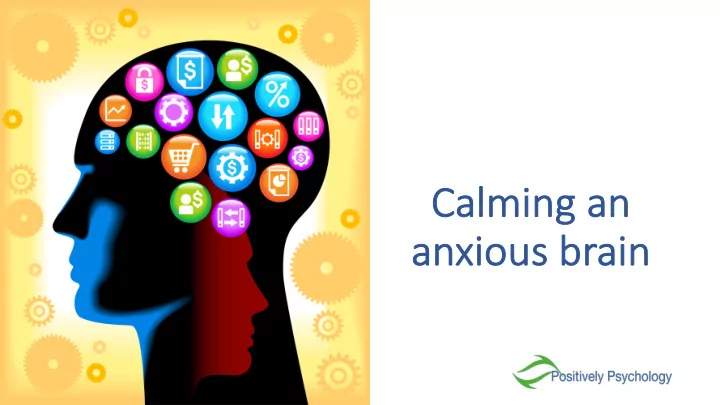

Ca Calmi ming ng an n an anxio ious brain ain
An Anxiety and stress Children currently report more anxiety, maybe because: • We are more aware of anxiety • It is OK to talk about feelings like anxiety • Easily built into stories • Children have fewer opportunities for natural mindfulness moments • Connectedness is ubiquitous – no release • Less optimistic about the future Adults are programmed to be attuned to children’s emotions Stress is reciprocal
What changes may y we notice? 1. Concentration Difficulty concentrating, distraction 2. Performance Challenged by academic tasks 3. Participation Sense of hopelessness, disengagement, reticence around new activities 4. Sleep Sleep problems/tiredness, irritability, listlessness or nightmares 5. Actions Changes in behaviour, hair-trigger response, angry outbursts 6. Relationships and Play New preferences for play, reversion to younger behaviours, clinging, lowered tolerance, increased sensitivity or withdrawal 7. Somatic indicators Somatic problems, muscle tension, sore stomach, headache
1. Difficulty concentrating, distraction 2. Challenged by academic tasks 3. Sense of hopelessness, disengagement, reticence around new activities 4. Sleep problems/tiredness, irritability, listlessness or nightmares 5. Changes in behaviour, hair-trigger response, angry outbursts 6. New preferences for play, reversion to younger behaviours, clinging, less tolerance or withdrawal 7. Somatic problems, muscle tension, sore stomach, headache
The Triune Brain Th SMART BRAIN PROTECTIVE BRAIN SURVIVAL BRAIN
Ci Circuiting on on the fast and slow tracks • SLOW ROUTE : Circuiting from mid-brain to survival brain and smart brain – whole brain response. • FA FAST ROUTE : All resources circuit between the mid-brain and the survival brain – away from the smart brain.
Up Up-regulation of the sympathetic c nervous system Fight, flight or freeze response 1. Amygdala fires – • Neurotransmitters (e.g. adrenaline and cortisol) message to the • Increased heartrate hypothalamus • Pounding heart/tight chest/feeling of suffocation 2. Hypothalamus • Slowed digestion - distress orders release of • Dilation of pupils adrenaline from • Priming of muscle groups to respond, blood pituitary gland flow to muscles in arms • Numbness 3. Travels to the • Fainting adrenal cortex that releases cortisol. • Nausea • Hot or cold • Sense of time
Challenging anxiety y – ge general principles 1. Shift the focus away from the cause toward maintaining factors 2. Understand the context 3. Immediate focus: Bring children back to the moment – whatever it takes. 4. Long-term: Need increased experience of the challenging event. Just enou Ju ough disequilibrium to form new neural connections • Experience is better than hours of talking. • 5. Reduce avoidance activity that strengthens unhelpful neural connections/increase approach behavior in other areas. Attempts to directly reduce anxiety may be counterproductive • We grow in the direction in which we focus • 6. Accepting the experience required is usually the hard part. 7. Things may become more challenging before getting better.
Wha What can n we do do in n the he classr ssroom? 1. Teach children how to understand and manage anxiety – active role 2. Focus on breathing, language of amygdala, control of the primitive brain 3. Mindfulness – create space between you and anxiety – awareness of the moment – attend to what is – kindness to oneself – from head to whole body focus 4. Exercise (e.g. regular physical activity, pacing during panic attack) 5. Muscle relaxation, release of tension 6. Experience, not trying to avoid the challenge completely 7. Change relationships with the response
Narrative questions around anxiety: y: Some examples After assuring of safety and alliance (e.g. worry) • Tell me the story of the worry. • What do you call the worry? • How strong is the worry? (1-10, big and small etc) • What would worry look like if you drew it? • What would be better than the worry? • What makes the worry shrink? • What makes [what is better than worry] grow? • Has worry been around this week?
Recommend
More recommend